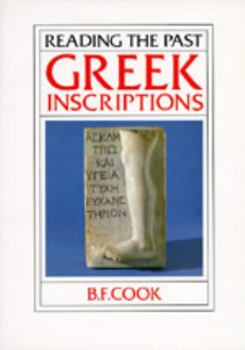Greek Inscriptions
(Part of the Reading the Past Series)
Introduces a wide variety of Greek inscriptions on stone slabs, pottery, bronzes, and other small objects, from simple names to more complicated texts, some in local dialects with distinctive... This description may be from another edition of this product.
Format:Paperback
Language:English
ISBN:0520061136
ISBN13:9780520061132
Release Date:December 1987
Publisher:University of California Press
Length:63 Pages
Weight:0.42 lbs.
Dimensions:0.2" x 6.7" x 9.4"
Customer Reviews
2 ratings
Brief but Clear Introduction to Greek Epigraphy, or Deciphering Ancient Inscriptions.
Published by Thriftbooks.com User , 14 years ago
"Greek Inscriptions" is part of the British Museum's "Reading the Past" series that introduces readers to ancient writing systems. B.F. Cook, former Keeper of Greek and Roman Antiquities at the British Museum, takes this opportunity to introduce laypeople to Greek epigraphy. The book is about Greek inscriptions, their uses, and the issues involved in deciphering them. It's not about the Greek language or the voluminous collection of writings on papyrus. Cook begins by explaining the Phoenician origins of the Greek alphabet and how alphabets varied by location before the Ionian alphabet superceded the others. Then there is a section about inscriptions on stone, followed by a section about inscriptions on other materials, such as bronze, pottery, and wood. Inscriptions on stone comprise the bulk of this 64-page. Cook starts out with the easiest to read, those inscriptions containing only names, such as epitaphs, which only require a knowledge of the Greek alphabet. He proceeds to more complex descriptions, increasing in difficulty as he goes on. There are about 25 examples of inscriptions on stone. You don't have to be able to read Greek, as translations are always provided, but some knowledge of Greek makes it more fun. There are 58 black-and-white illustrations, mostly photographs. Whenever an inscription is referred to in the text, the number of the illustration is noted in the margin. This allows readers to see what the writing actually looks like along with its transcription into readable miniscule Greek. So we can get an idea of what epigraphers deal with, including the challenges of slightly different Greek alphabets.
A perfect introduction
Published by Thriftbooks.com User , 23 years ago
This book does exactly what it's supposed to, which is introduce to non-specialists the nature of Greek epigraphy. More than that though, it also serves as a nice introduction to the field for beginning students with ample, clear examples of Greek inscriptions given in photographs, then typed in Greek, and translated. The section on the Alphabet, with a table of regional variants, is a nice touch.The references are great starting points for beginning students, and the Further Reading section at the end is concise but well selected. This is a simple, straightforward text that will help promising scholars begin to make sense of the field while allowing lay-people to understand the significance epigraphy has had on our understanding of Greek history.Upon finishing this text, be sure to look into Woodhead's "The Study of Greek Inscriptions," which the authors, and I, recommend as "the indispensible textbook." Yet Woodhead, as good as it is, has not the examples or ease of this little paperback.





